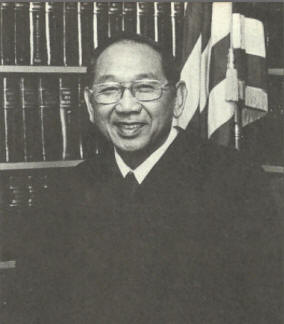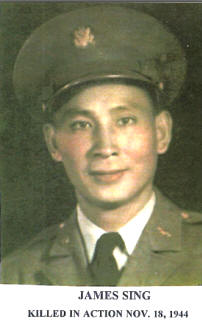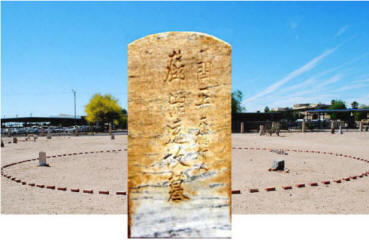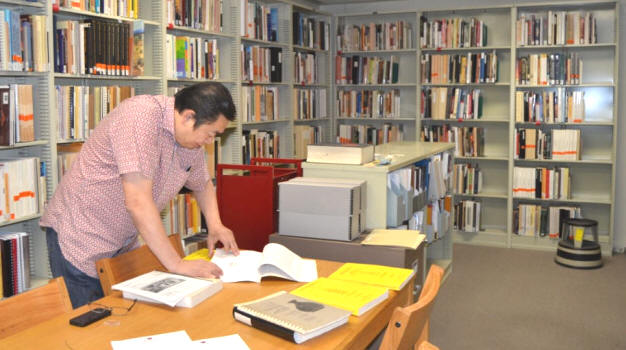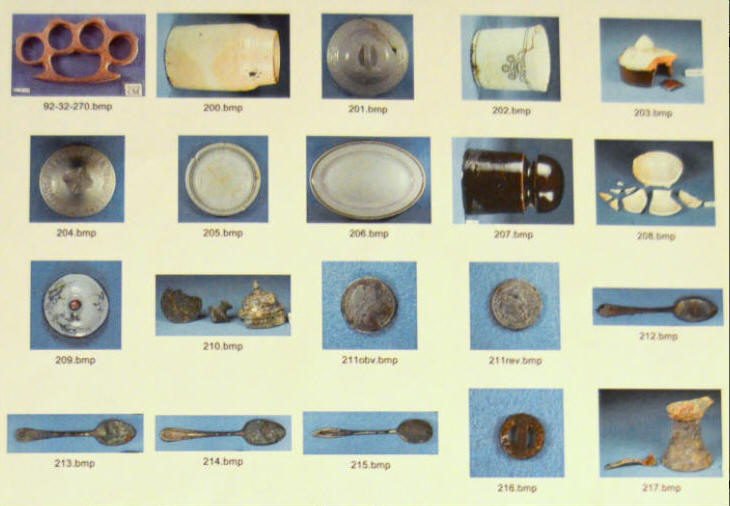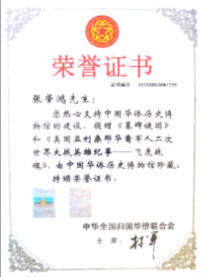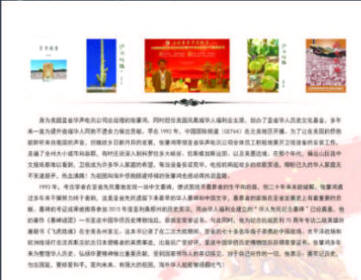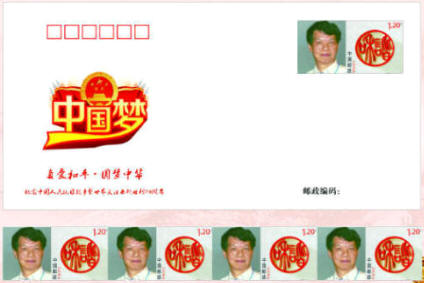|
Work hard to discover early Chinese immigrants' contributions Phoenix's Pioneer & Military Memorial Park is one of the earliest cemeteries in Phoenix with significant historic values. The cemetery is the burial ground for many famous people and preserves much importantinformation about the early settlers of Arizona. On the 11-acre cemetery divided into seven zones, there are 3,700 tombs and about 600 tombstones. The early Chinese settlers were buried among the poor in the cemetery. From 1886 to 1914, there were 50 Chinese and Chinese descendants buried in the cemetery and many of these Chinese’ remains were later transferred back to China by their loved ones. Since these Chinese did not appear on the obituary sections of the local newspapers, there is very limited information in identifying these Chinese nor their families and descendants. In the last century from 1991 to 1992, Arizona State University archaeologist K. J. Schroeder excavated a tombstone with Chinese inscriptions in a downtown “Pioneer & Military Memorial Park”( PCA) , He tried to find the descendants of the tomb in order to promote the glorious history of the overseas Chinese pioneering the Arizona. He seek the help of Chinese scholars Mr. William Tang. but, Many years passed, the search for the descendants of the tome returned no results, due to the fact there was no one who could figure out the name of the dead on the tombstone which was translated from the accent of the Canton dialect. As a result, who the occupant of the tomb is still remains unknown in the cemetery historical archives.
the occupant of the tomb is still remains unknown in the cemetery historical archives. Homer Zhang (Phoenix Chinese Welfare Council president ) has spent many years investigating at the cemetery, in hopes of unraveling the mystery tombstone. There are only a few Chinese words inscribed on the tombstone -- “Kai Ping Da Lou Villager, Ong Shiang Yuen.” The word “Deng” was written astonishingly and the “Yuan” impressively. If the word “Yuan” were taken apart, one would think of the overseas Chinese ancestor who, in order to “earn his living,” brought a handful of hometown “soil” with plodding pace before boarding on a no-way-out “boat” and came to the so called “gold mountain.” It is not just a personal name, but a reality-- far away from hometown, it seems he who died abroad at last is forgotten by loved ones and as time goes by; his grave no longer exists with only lonely tombstone; worse still, his soul is unable to return home but become a lonely soul and ghost wandering in the cemetery of desolate wilderness for over a hundred years. In early times after Deng’s burial, relatives had paid him tributes, but the grave left unvisited for years as they passed away.
Mr. Zhang started to look online for information about Kai Ping Da Lou Village, yet he found nothing but a zip code! When Mr. Zhang almost abandoned himself to despair, Phoenix Chinese Welfare Council ,Ong Ko Met Family,Pioneer & Military Memorial Park,PCA Volunteer Donna Carr , Mr. William Tang , and many senior overseas Chinese from Kai Ping offered him help and clues. After 20 years of unremitting information accumulation and efforts to explore, Mr. Zhang finally discovered the meaning of “Yuan” in the Deng family genealogy records and unraveled the life story of the tomb occupant. According to Mr. Zhang’s research, the tombstone and the Chinese inscriptions were identified as the earliest pieces of cultural relics Phoenix overseas Chinese ancestors left behind; and the Xiang Yuan Deng family actively made contributions to culture, economy, military and law in Arizonahistory.
Relics of a century old in the United States that was founded over 200 years ago are as precious as those of a thousand years old discovered in China. In this historical memorial cemetery, were once buried 50 early Chinese settlers. Later, some of their remains were transferred back to China by their relatives, some moved to other cemeteries, and the 22 unclaimed still stayed. Currently, except the genealogy of the tomb occupant, Deng Xiang yuan family before and after the generation of six generations of genealogy has been found, there are merely names in English of Chinese accent and other incomplete information about the rest of the tomb occupants. Because they are the first batch of Phoenix Chinese from China, the local Chinese community held a commemorative ceremony for them.
May 26, 2014, Chinese community leaders and members of the Chinese community organizations visited the Chinese cemetery of the Pioneer & Military Memorial Park in commemorating the Chinese ancestors and pioneers with wreath flowers. They were senior Chinese community leader John M. Yee, and representatives from Chinese United Association of Greater Phoenix, Phoenix Chinese Welfare Council, Ong Ko Met Family Association, Yee Fung Toy Family Association, Kaiping Benevolent Association of Phoenix, Chinese Restaurant Association of Arizona, Ying On Merchants & Benevolent Association, Taiwan Benevolent Association of Phoenix, Lung Kong Family Association of Phoenix Arizona, Phoenix academia, Arizona Sunbird News. Initiated by the senior Chinese community leader, John Yee in 2014, the Phoenix Chinese Welfare Council decided to raise funds for the building of a memorial tombstone in order to honor the Phoenix Chinese ancestors for their contributions, and to allow the souls of those unclaimed tomb occupants to rest in peace and receive tributes from the Chinese community.
This decision has been highly valued and strongly supported by the management of the Phoenix Pioneer & Military Memorial Parks and Greenwood/Memory Lawn Mortuary & Cemetery. Having gone through quite a few procedures and long waiting, the monument was finally built and shipped from China to Phoenix. September 16, 2015, the Chinese United Association of Greater Phoenix organizations in Arizona held a memorial tombstone laying ceremony.
November 21,2015 Held memorial. The Foundation Ceremony for the Monument to the Phoenix Chinese Ancestors Phoenix's Pioneer & Military Memorial Park is one of the earliest cemeteries in Phoenix with significant historic values. The cemetery is the burial ground for many famous people and preserves much important information about the early settlers of Arizona. On the 11-acre cemetery divided into seven zones, there are 3,700 tombs and about 600 tombstones. The early Chinese settlers were buried among the poor in the cemetery. From 1886 to 1914, there were 50 Chinese and Chinese descendants buried in the cemetery and many of these Chinese’ remains were later transferred back to China by their loved ones. Since these Chinese did not appear on the obituary sections of the local newspapers, there is very limited information in identifying these Chinese nor their families and descendants. In 1993, ASU anthropologists K.J Schroeder and his archaeological excavation team excavated the cemetery and unearthed some Chinese coins, bone made tools, jade, small Bodhisattvas and other objects. The archaeologist published the book, "Pioneer & Military Memorial Park Archaeological Project in Phoenix Arizona 1990-1992." Among the early tombstones in the cemetery, there is only one with Chinese inscription - "Grave of Xiang Yuan Tang, Kaiping Dai Lou Village.” With little clues about this tomb, the archaeologist reached out to the Tempe Chinese school principal, William Tang. Mr. Tang published a message in the local Chinese newspaper, hoping to find the descendants of the tomb in order to study the life, thoughts and family of the tomb owner and to promulgate the glorious history of the Chinese pioneers. But 20 years passed by, the tombstone mystery had remained unsolved.
Homer Zhang( President of Phoenix Chinese Welfare Council), has spent years in collecting relevant information in hopes to unravel the mystery tombstone, through querying Chinese family names, researching genealogy records, visiting former overseas Chinese, and inquiring cemeteries in U.S. and China. Mr. Zhang published over 10 articles online and through local Chinese newspapers on the mystery tombstone. Mr. Zhang’s articles received vast feedbacks from the Chinese communities -- many senior overseas Chinese provided clues and the cemetery offered help. After years of effort, the mystery had finally been solved. According to Mr. Zhang’s research, Xiang Yuan Tang is found in the genealogy records of the family of Thomas Tang (1922-1995), Justice of the U.S. Ninth Circuit Court. Xiang Yuan Tang is one of earliest Chinese settler in Arizona and his tombstone is the earliest tombstone inscribed with Chinese characters. His tombstone provides great reference value for the future research of Chinese history in Arizona. May 26, 2014, Chinese community leaders and members of the Chinese community organizations visited the Chinese cemetery of the Pioneer & Military Memorial Park in commemorating the Chinese ancestors and pioneers with wreath flowers. They were senior Chinese community leader John M. Yee, and representatives from Chinese United Association of Greater Phoenix, Phoenix Chinese Welfare Council, Ong Ko Met Family Association, Yee Fung Toy Family Association, Kaiping Benevolent Association of Phoenix, Chinese Restaurant Association of Arizona, Ying On Merchants & Benevolent Association, Taiwan Benevolent Association of Phoenix, Lung Kong Family Association of Phoenix Arizona, Phoenix academia, Arizona Sunbird News. There is a deep feeling about the fifty Chinese pioneers who buried in the early Chinese cemetery. Either in life or after death, these Chinese are classified with low status, subjected to discrimination in the era of anti-Chinese. Their lives were filled with a lot of sad stories. Xiang Yuan Tang’s thin little tombstone is a humble portrayal of the Chinese status during the era. As Tang was buried ages ago, it seems it is so difficult for his soul to return to hometown and join his loved ones. His tombstone stands in the neglected cemetery in self-pity, as if it is waiting ... in solitude years. Today, the page of Chinese pioneers is finally turned. Chinese tombstones provide us with precious historical and cultural heritage values. From now on, "the First Chinese Cemetery Monument" and the name of Xiang Yuan Tang will no longer be forgotten. Followings are two pictures Homer Zhang took in contrast: one by the Xiang Yuan Tan’s tombstone at the old cemetery, and the other by the Chinese Cemetery Memorial monument at the Greenwood Memory Lawn Mortuary & Cemetery.
The current Chinese cemetery is located at Greenwood Memory Lawn Mortuary & Cemetery. Greenwood Memory Lawn Mortuary & Cemetery is founded in 1906 and it is the largest cemetery in Arizona. In 1992, Chinese community leader, John M. Yee, realized the Chinese cemeteries were not centralized in term of location. Therefore, he worked with Phoenix Chinese Welfare Council and the Greenwood Cemetery management to negotiate the opening up of the Phoenix’s first "Chinese Cemetery Park" (Chinese Memorial Garden). The Greenwood Cemetery management not only established a monument to commemorate the Chinese cemetery, but also developed a sector as "royal cemetery," namely luxury grave sites, reflecting the management’s high level of respect for the Chinese. This level of respect would never occur in the past. As result of the high respect in the Chinese culture and customs, there is a great demand for the Chinese to choose the Greenwood Cemetery as their burial site. Today as the Chinese social status has been significantly improved and have integrated with the mainstream, they are no longer depressed with injustice of the past, but more actively to face it and involved to improve the system. They also take the courage to participate in the future development and innovation. Currently, the old Chinese cemetery still has about twenty Chinese ancestors buried there. The Phoenix Chinese Welfare Council decided to establish a monument in memory of these Chinese pioneers in Arizona for their great contribution to the Chinese community. This decision has been strongly supported by the Phoenix city government, executives of the cemetery and Chinese United Association of Greater Phoenix. The monument has now been built .
鳳凰城的先鋒軍紀念公園是鳳凰城最早的墓地之一,具有重要的歷史價值。 公墓是許多著名人民的墳場,並且保存關於亞利桑那的早期定居者的許多重要信息。 在分成七個區的11英畝公墓,有3,700個墓葬和約600個墓碑。 早期的中國移民被埋在墓地的窮人中間。 從1886年到1914年,有50個中國和中國後裔被埋在墓地,許多這些中國遺骸後來被他們的親人送回中國。 由於這些中國人沒有出現在地方報紙,在辨認這些中國人及其家人和後代方面信息非常有限。 在上世纪1990-1992年, ASU大學的考古學者 K. J. Schroeder在鳳凰城市中心的"先民和軍人紀念墓園" (Pioneer & Military Memorial Park) 中,發現了一塊中文墓碑,他試圖找尋墓葬者的後人,藉此宏揚華人開拓亞省的光榮歷史。并尋求華人學者唐孝先先生的幫助,但因死者的姓名是以鄉音譯成英文,不諳廣東方言難於去調查。所以20多年過去,仍找不到的墓葬者的後人。因此在墓園的歷史檔案中,存留著一個未能解開的"墓碑之謎"。 為解開這個謎團,張肇鴻 (鳳凰城華人福利會主席) 多年來一直在做資料搜集,多次去墓園進行調查。華人墓地上的中文墓碑只寫有:"開平大樓村人鄧湘遠墳墓"。"鄧"字寫得很有氣勢。"遠"字也很有特色。如把"遠"字拆開來看,讓人聯想到華人先輩為了糊"口",帶上了故鄉一把"土",邁著沉重的腳步,上了一條沒有歸程的"船",來到了這個被人稱為"金山"的地方。這不單是個名字,更是實況,家鄉萬里迢迢啊!墓葬者似乎忘掉了歲月,忘掉了親人,最後客死在異鄉。他的墳墓早已不存在,墓碑形影相弔,連生來死去的日期也未留下。但最可悲可嘆的,是歲月也忘掉了他,至親也忘掉了他,他不能魂歸故里,最終成了孤魂野鬼,在這荒野墓園寂寥悲涼地存在了一百多年! 雖然早期也有些族人來拜祭過他,但隨著親屬故去,墓地多年來再沒有人来过! 在互聯網上尋找開平大樓村的資料,但也只能找到一個郵區號碼而已!往事如煙,几近絕望時,張肇鴻得到了鳳凰城華人福利會,鳳凰城鄧高密公所、先民和軍人紀念墓園 志工Donna Carr,學者唐孝先先生,,還有许多開平老僑們熱心提供線索,經過20年不懈的资料積累和努力發掘,最終在鄧氏族譜中查到這個"遠"字的內涵,得以解开墓碑主人的身世。現已查明,華人墓地上這塊惟一的墓碑和文字,是鳳凰城華人先民遺留下來最早的文物,而所查到的鄧湘遠家族,無論在文化、經濟、軍事和法律方面,在亞省歷史上都有過積極的貢獻。 美國立國二百余年,百年前的遺物就如中國發現千年前的文物那般的珍貴!在這歷史紀念墓園中,曾經埋葬著最早來到鳳凰城的五十位華人先民,他們其中有部分人的骸骨已被早期的親屬起出後運回到中國,部分遷移到其它墓園。剩下的還有22位無人認領先民的骸骨,仍葬於此地。目前,除墓碑主人鄧湘遠前後6代人的族譜經已查明外,其余的墓葬者只留下鄉音的英文姓名和殘缺的資料。因为他们是第一批來自中国的鳳凰城華人,本地華人社區為他們舉行了紀念儀式。 參加次這追悼活動的有資深僑領余文勁,學術界代表唐孝先,鳳凰城僑聯總會主席余文澤,僑聯前主席鄧朝駒,斐匿華人福利會主席張肇鴻,鄧高密公所主席鄧豐占、成員鄧家彥、鄧家健,開平同鄉會主席關兆峰、副主席鄧汝楊,余風采堂代表余富強,榮光會理事高志中、中國餐館協會董事巫宜釗、成員朱其華,台聯會名譽主席陳彩屏、其女兒朱莞菁,美國陸軍憲兵士官朱莞菱,龍岡公所書記張萬波、代表劉陳愛卿。亞省太陽鳥華人網主編謝成彥。《美西僑報》、太陽鳥華人網、鳳凰華人資訊網、鳳凰藝文網全程關注和報導"墓碑謎團"組文。娟娟花店制作了追悼活動的花圈和花籃。 為了紀念鳳凰城華人先民對亞省歷史開拓的貢獻,也為了讓墓地上這些查不到後人的靈魂得到安息,今後能得到華人的憑吊和拜祭,故在2014年,由資深僑領余文勁先生倡導,並由鳳凰城華人福利會捐款,由Greenwood Memory建造"華人先輩紀念墓碑"。 此計劃得到了"大鳳凰城僑聯總會","先民和軍人歷史紀念墓園"和"綠木墓園"領導的高度重視和大力支持。由於建造墓碑的手續繁多,經過了經年的運作和等待,"華人先輩紀念墓碑"終於由中國運回至鳳凰城。2015年9月16日,大鳳凰城僑聯總會舉行了墓碑奠基儀式。 《鳳凰城華人先民紀念墓碑 》 1993年,ASU大學研究人類學者K. J. Schroeder和考古小組在鳳凰城的《先民和軍人紀念墓園》(Pioneer & Military Memorial Park,出土了一些中國錢幣、骨器、玉器和小菩薩像等物件,考古學者主編了一本書籍:"Pioneer & Military Memorial Park Archaeological Project in Phoenix Arizona 1990-1992"。 墓地中有惟一的一塊中文墓碑,墓碑矮小單薄, 碑文只有:"開平大樓村人鄧湘遠墳墓",沒更多的線索。K. J. Schroeder請華人學者唐孝先先生,在華人報刊上刊登消息,試圖找尋墓葬者的後代,以期研究其生平、思想、家族等,藉此宏揚華人開拓亞省的光榮歷史。但20多年過去了,郤一直未能解開這個"墓碑之謎"。 張肇鴻(斐匿華人福利會會长)多年來搜集相關資料,並將得到的資料作出整理,希望能解開這個墓碑謎團。在尋覓過程中,從查詢姓名到翻閱族譜,從跟進歷史到拜訪前僑,從美國墓園查詢到中國僑鄉。張肇鴻在華文報刊和網站先後發表了10篇文章,引起僑界反響,有不少老僑提供線索,並得到墓園方面的協助,經過多年的努力,終於讓謎團有了答案。資料顯示:鄧湘遠是很早就來到亞利桑那州的華人,他的墓碑是亞省華人遺留下來的最早的墓碑,碑文是亞省最早的中國文字。墓碑對今後研究亞省華人的歷史文化有很大的參考價值。而在鄧湘遠後代的族譜中,有一位是美國第9巡迴法院大法官鄧心平(1922年—1995年),鄧心平名字的出現,讓墓碑謎團到最後帶出了一個個光環。 2014年5月26日,鳳凰城僑界到《先民和軍人紀念墓園》展開對華僑先民的追悼和拜祭活動。包括資深僑領余文勁、鳳凰城僑聯總會、斐匿華人福利會、鄧高密公所、余風采堂、開平同鄉會、中國餐館協會、榮光會、臺聯會、龍岡公所、學術界、亞省太陽鳥華人網等團體的成員,向華人墓地獻上花圈花藍,鞠躬致敬,在慎終追遠中,寄托對華人先輩的悼念。 有一個很深的感觸,在早期華人墓地裏埋葬有五十華人,當年無論生前死後都是地位低微,是受岐視的一族,在那個排華時代,他們有著許多心酸的故事。百年前鄧湘遠先輩的墓碑矮小單薄,有如是那個時代華人的歷史地位低微的寫照。由於年代久遠,鄧湘遠連魂歸故裏、尋覓至親之路也困難重重。他的墓碑在曠野荒塚中自憐,在歷史寂寥歲月中等待......。今天,這一頁終於翻過。墓碑為亞省華人留下了一份珍貴的歷史文化遺產。今後,"華人墓園第一碑"和鄧湘遠名字將不會再被人們遺忘。張肇鴻專門去和鄧湘遠的墓碑照了張相,也去了另一個"綠木墓園"的"華人紀念墓園"碑照了一張相,以此用作對照。鳳凰城"綠木墓園"(Greenwood/Memory Lawn Mortuary & Cemetery)創建於1906年,是亞利桑那州最大的墓園 。 一九九二年,亞省的著名僑領余文勁先生,有感於華人墓地不集中,聯同華人福利會和綠木墓園管理層商議,新開辟出亞省首個"華人墓地公園"(Chinese memorial garden),不但樹立有紀念墓園石碑,還專門內建尊貴地位的"王室墓地",充分反應出綠木墓園高層對華人地位的尊重。這是在一百多年前,華人做夢都想不到的變化。由於墓園為華人著想,尊重華人的文化風俗,目前已有大批華人置地安葬。 今天,華人的地位有了顯著的提升,在不斷地溶入主流社會中,觀念和胸懷也在不斷擴充,華人不再沈鬱在過去的歷史和社會所給予的不公,而是更積極去面對,為日臻完善制度作出貢獻,並勇於參與未來的開拓和創新。 華人墓地仍埋葬著廿余位華人先民,斐匿華人福利會決定為他們立一個紀念墓碑,讓這些在最早期開拓亞利桑那州華人的先民們,也能得到應有的地位和尊重。這個決定得到了鳳凰城市政府 、墓園決策高層和鳳凰城僑聯總會的大力支持和高度重視,墓碑已建造好, 鳳凰城僑界舉行了公祭儀式活動。 一,鄧湘遠家族對華人先民歷史的貢獻 http://www.paaca.us/new_page_dgy-mb14.htm 二,鄧湘遠家族對 亞利桑那州經濟方面的貢獻 http://www.paaca.us/new_page_dgy-mb16.htm 三,鄧湘遠家族對美國法律和軍事方面的貢獻 http://www.paaca.us/new_page_dgy-mb17.htm 「墓碑迷團」解開後,鳳凰城僑聯總會繼續支持發掘華人先民歷史和查詢墓地出土文物的去向。僑聯主席鄧洪龯和華人福利會主席張肇鴻去博物館和大學圖書館查閱,獲得了大量相關的文件、相片,以及出土文物的資料。但這些文物和資料,目前絕大部分都收藏在圖書館內和博物館密室的封存中,華人先民的物件有過百件!如何讓這些文物重見天日,讓我們的下一代能了解更多早期華人先民的生活和奮鬥歷史,建立華人歷史博物館,還需要我們華人自身去作不懈的努力!
《墓碑謎團 》(Chinise) http://www.paaca.us/new_page_144.htm
|
_files/image002.jpg)
_files/image004.gif)
_files/image006.jpg)
_files/image008.gif)
_files/image010.gif)
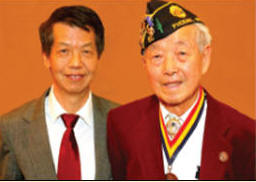
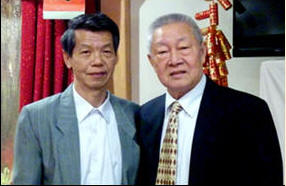
_files/image012.gif)
_files/image014.gif)
_files/image016.jpg)
_files/image018.gif)
_files/image020.gif)
_files/image022.gif)
_files/image024.gif)
_files/image026.gif)
_files/image028.gif)
_files/image030.gif)
_files/image032.jpg)
_files/image034.jpg)
_files/image036.jpg)
_files/image038.jpg)
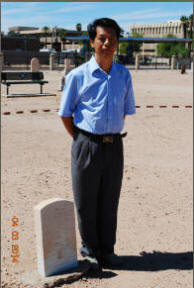
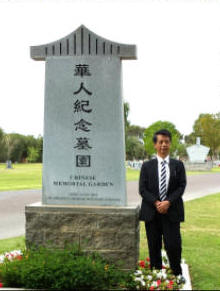
_files/image040.gif)
_files/image042.jpg)
_files/image044.jpg)
_files/image046.gif)
_files/image048.gif)
